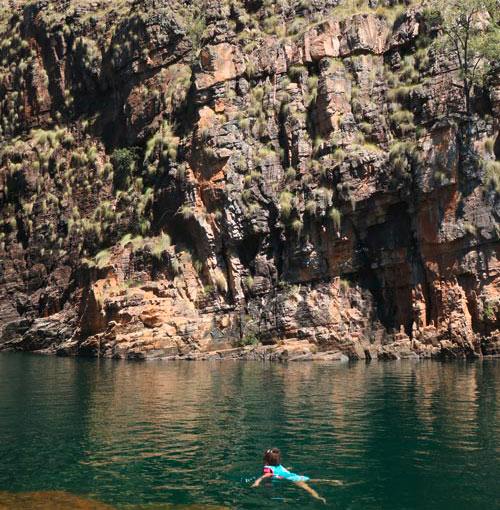Alone with a six-year-old, Lydia Bell takes a whirlwind tour to Australia’s wild Top End and the Great Barrier Reef
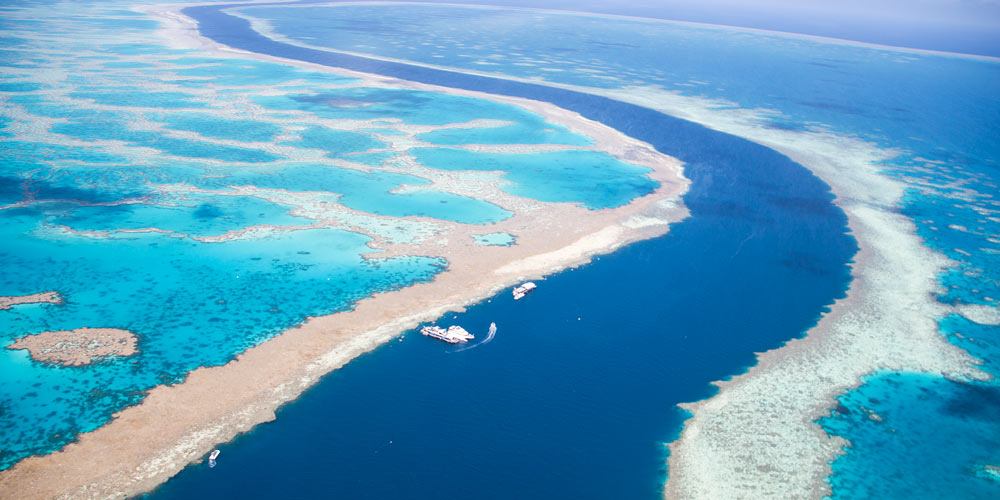
This summer I took my six-year-old daughter to Australia. My second country, it is the homeland of my mother and where I spent some happy years in my twenties. I still remember the family holiday we took to Queensland when I was the same age as my daughter now, and the sense of wonder and excitement I felt about seeing kangaroos in the bush and manta rays and hammerhead sharks on the reef.
I wanted to imbue in her that feeling of adventure transmitted by the Australian outback and the Great Barrier Reef. I also wanted to test drive the idea of taking her with me on a long-haul foray into the wilderness, something that is a part of who I am.
A few short dawns after leaving the familiar confines of southeast London, we were in a game vehicle, catching the last rays of sun in the wilds of Australia’s Northern Territory on the cusp of Kakadu National Park. From every side there were alien things to see and hear: raucous corellas exiting pandanna palms, wallabies bouncing, egrets balancing on buffalos and galloping brumbies.
We stopped for sundowners amid termite mounds overlooking the vastness of the floodplains with the brooding fringe of a paperbark swamp on the horizon. Over on the floodplains, crocodiles lurked.
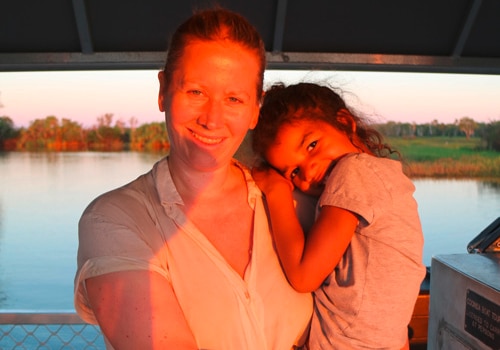
Cruising for crocodiles at Yellow Waters,
Northern Territory
We were in Bamurru Plains, where your bedroom is a canvas-covered room on stilts. Wildlife can’t see in, but you can see out. At dawn, a chorus of blue winged kookaburra wake you and your first morning sight is of wallabies sauntering by.
There’s a pool overlooking the floodplains framed by a wooden deck and fronds of pandanna palms that the sun bursts through. Going out onto those floodplains in one of their airboats is a highlight. So off we went. The motor is so noisy that as you’re flying around that you need to wear giant earmuffs.

Feeding wallabies at Cooberrie Park Wildlife Sanctuary, one of 12 places in the world you can cuddle a koala
We flew around the magical green flat world of the floodplains as if on a flying carpet, elegant magpie geese taking off on their magnificent wings as we passed. Another day at sunrise, we visited ‘The Hide’. This platform raised 20ft to the edge of the floodplain has been fashioned out of an upended shipping container and has 360-degree views. You can also be dropped here with a picnic hamper for a lunch. The daring sleep out here at night in a swag and they come and pick you up in the morning.
The only family that have slept here this season encountered a large olive python in the morning – much to the children’s delight apparently. I decided against it in the end. You can’t leave the confines of the mosquito net or wander down to the bottom of the hide where there are crocs and buffaloes. I thought that, after the initial excitement, it would be just too constricting for a six-year-old.
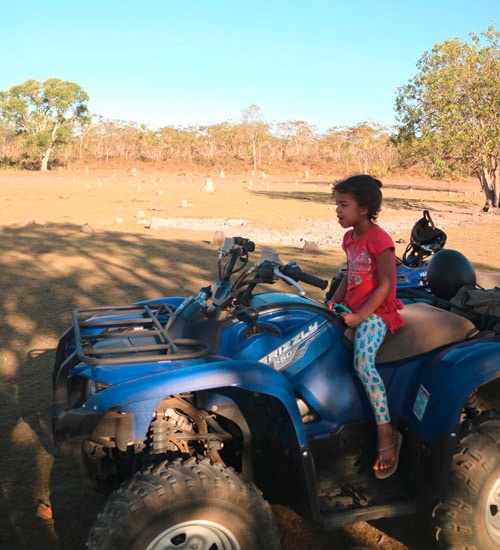
Quadbiking at Bamurru Plains in the Northern Territory

On the beach at Pumpkin Island in Queensland, where you can snorkel straight off the beach into a fringing reef
Last year, disaster struck in the Top End – the wet season never arrived. This meant that one couldn’t go out in the airboats at Bamurru. The lodge invested in some quad bikes. They made for a hilarious afternoon out with her clinging on to my back as we raced along dusty tracks through the paperbark forest and along a small road to a bore billabong where we stopped for a drink.
The billabong was studded with termite mounds created by ant saliva and dirt, and as hard as concrete – back in the day in bush towns they made tennis courts out of them. The only glitch of the afternoon was that my new white t-shirt returned as an orange t-shirt and has remained thus ever since.
Children are welcomed at Bamurru Plains from the age of six. I would say that the optimum age would be eight upwards and the golden age would be ten, but six is manageable as long as you’re clear about the rules and they are the kind of child who can fit into adult routines without much complaint, as meals and excursions are communal.
The food is special, and could range from anything from ginger smoked wild barramundi to emu salads, but there are no planned concessions, so you need to explain to the friendly chef that it’s probably not worth bringing out his beautifully crafted prawn cocktail, and could the main maybe be the leftover spag bol from the staff dinner, instead of the mud-crab ravioli? They will understand.

Cruising for crocodiles at Yellow Waters, Northern Territory
For our night out in a tent, Lords Safaris, the sine qua non of bush travel specialists in the Top End, picked us up. They took us to Kakadu National Park and that night, we camped in their atmospheric private bush camp there. I say camping – with Lords Safaris it’s camping for softies. They have proper beds with sheets and fans, and a pop-up ‘eating room’ so you can eat without the mossies. You get perfectly cooked steak primed over a firepit and can rummage around in an esky to for your wine of choice while Sab Lord regales you with tales of the bush.
Dean Hoath, also of Lords Safaris, who is magic with children, took us down a one-kilometre track through monsoonal rainforest to Maguk, a gorgeous natural plunge pool into which a waterfall thundered. Because of the shallow creek line, crocs do not venture upstream here – although there are croc traps just in case – so in blissful, still, peacock green waters, my daughter floated in the heat. The waters were deep and I put a little lifejacket on her just in case.

Near the ubiquitous termite mounds at Bamurru Plains
Just before sunset we took a private boat down the river at Yellow Waters, which is an Australian Garden of Eden and a world of birds – everywhere white-bellied sea eagles, kingfishers, egrets in flight, the blue flickers of kingfishers and damsel flies. This is the place to catch flashes of the prehistoric elegance of the Australian saltwater crocodiles – sunning themselves on the riverbank with curled spiky tails and surfacing to hunt, gliding alongside the boat, their eyes poking above water level.
After a giant tangerine ball of sun plopped beyond the horizon, the owner of the cruise boat allowed my daughter to navigate the boat over the still evening waters back to its mooring.
‘Turn right here little sister, now turn hard left. No, not that hard,” I heard him saying carefully. She was in seventh heaven.
Jumping on an internal flight to Rockhampton we swapped the dusty oranges and luminous greens of the Top End for the deep blue palette of Queensland. Here, my fantasy was to re-create a holiday I had thirty-five years ago, aged six on Heron Island.
I still remember the Robinson Crusoe beauty of this Southern Great Barrier Reef haven, its vivid corals and fluorescent fish. This time we were headed to Pumpkin Island, which is much more accessible from the mainland.
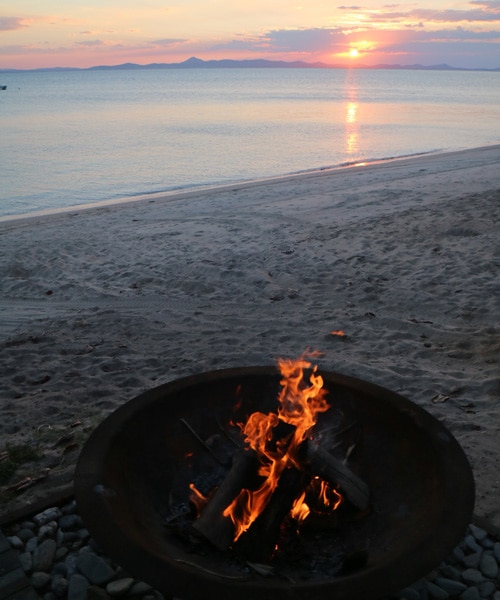
The view at sundowners on Pumpkin Island
The enchanting Keppel Archipelago is brilliantly situated only 12-14 kilometres offshore. You take a twenty-minute ferry from Yeppoon Beach on Keppel Bay, a curvy sweep of glittering ocean off the central Queensland coast with picture-perfect, generously proportioned beaches. Lacking the sleeker resorts of far north Queensland, or the Whitsundays, the Keppels’ selling point is really their accessibility and affordability. They sit within the Great Barrier Reef World Heritage Area, but theirs are fringing reefs so you just throw on a mask, snorkel and flippers and get out there – no long boat trips.
It’s perfect for younger children to have island-adjacent reef snorkelling as an option without having to take a long boat trip out to a reef. Miniature Pumpkin Island is a hidden secret. It totals only six hectares with has a few, well-spaced-out, sun-and-wind-powered pretty cottages dotted on its shoreline. A young South African couple Wayne and Laureth own and run the place, living in a cottage there with their toddler and tiny baby, Indie and Haven.

Waiting for a boat to take us from Great Keppel Island to Pumpkin Island with a local lodge owner
My daughter was over the moon just to be here swinging in hammocks, making sue of the climbing frames and swings, running in and out of the water with their children, making patterns in the sand, collecting shells and singing and dancing to herself outside our cottage, which was tucked away on the furthest point of the island where there was no one else around (although we could be at the ‘main’ beach in about one minute flat).
The cottages are all self-catering but we came equipped with a sealed esky packed with goodies from the Waterline Restaurant in Keppel Bay Marina – the easiest option if you don’t want to drag groceries with you from the mainland, and one that can be arranged by Wayne and Laureth.
The Waterline provided ingredients and recipe instructions so we had a selection of gourmet goodies to eat. Zero thinking required and only a modicum of cooking. We had steak and seasonal vegetables, Keppel Bay Bug and green tea noodle salad, bruschetta, prawn slider rolls, spaghetti Napoli, and bacon and eggs. The fridge was stocked with lovely snacks, wines and beers. One day we took off on Wayne’s boat and jumped off over the coral reef.
I was snorkelling and my daughter was on a small boogie board next to me with a glass window cut out of it so she could see down to the coral and the fish below. After all the terrible news about the Great Barrier Reef in recent years, it was heart warming to see healthy, vibrant-looking soft corals and brightly coloured fish here. There were kite butterfly fish, clown fish – there’s a colony here – copper band butterfly fish, trigger fish, damsel fish, and very healthy looking squishy soft corals, sponges and anemones. I was so glad that she had been privileged to see this marvellous underwater eco-system with her own eyes, like I did at her age.
It was hard to leave, but the end point to our Australia adventure fulfilled another dream – to cuddle a koala. As luck would have it, just 15 minutes out of Yeppoon Beach is the beautifully lush and jungly Cooberrie Park Wildlife Sanctuary, one of only 12 places in the world where you are allowed to hold one. From the minute you walk through the turnstile, greeted by a cockatoo, to the moment you leave and the manager sauntered out to with a chubby sugar glider wrapped in a blanket that she was nursing back to health, it was a winner.

She cuddled an orphaned joey, hand fed a giant cast of wallabies, chatted to sulphur crested cockatoos, watched dingoes sleeping, ran away from curious emus, was surrounded by resplendent male peacocks and admired at a smorgasbord of massive snakes. Cooberrie’s cassowaries, Judy and Henry, are the stars of an important breeding programme. Henry was sitting on eggs, and unavailable for conversation. These dinosaur-esque creatures have changed so little over the process of evolution that the animators of Jurassic Park studied their running movement.
Best of all though were the koalas, keen to get out of their enclosures for a cuddle. Depending on geography, koalas in Australia range from being extinct to endangered, which is why the breeding programmes of sanctuaries like Cooberrie Park are crucial. The handler plucked out Capri, who at nine years of age was already a grandmother. He explained that my daughter should stand still like a tree and make a cradle with her arms to hold the koala’s bottom.
“She’s quite heavy!” she squeaked nervously. “She’s digging her claws into me!” I also held her – she was as docile and fluffy as a soft toy. As a single mother I had been apprehensive about what it would be like bring my young daughter as far as Australia.
Would the flight be a nightmare? Would travelling so far into those environments be stressful? Would she see the point of it? Would I?
A part of me, I know, needs to prove to myself that I can live the life that I want regardless of having my young daughter. The answer to these questions is yes – it is entirely possible, and she did want to embrace everything. In truth, this high-octane, Australian adventure was tiring. But it was also precious, unforgettable, and worth it.
